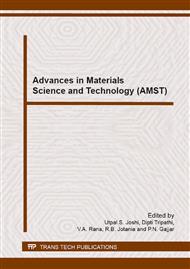p.156
p.160
p.164
p.169
p.173
p.177
p.182
p.186
p.190
Single Crystal Growth of Bi:Sb Alloys
Abstract:
The solid-liquid interface of Bi (1-x) Sb(x) crystal growth is most favorable for investigation of electron and phonon phenomena. Bismuth is a semimetal with high electron and hole mobility. Interest in Bi-Sb material system has recently been stimulated by promise of a new generation of thermoelectric materials based on these alloy. The crystals were grown using zone melting method with 1.0 and 1.5 cm/hour growth velocity and temperature gradient 650C/cm. The surface was determinal on the basis of growth feature profiles under optical microscope. The features observed on the top-free surface of as-grown crystals have also been discussed. The crystals have been characterized by using the powder XRD technique. The optical absorption was measured in the wave number range 510 cm-1 to 4000 cm-1. From the optical absorption through direct inter band transition.The results are reported and discussed in detailed.
Info:
Periodical:
Pages:
173-176
Citation:
Online since:
November 2013
Price:
Сopyright:
© 2014 Trans Tech Publications Ltd. All Rights Reserved
Share:
Citation:


